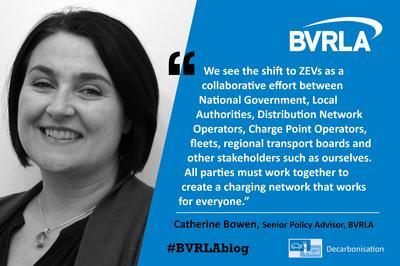Following the launch of the association’s 2023 Road to Zero Report Card, Catherine Bowen, Senior Policy Advisor at the BVRLA looks at the UK’s charging infrastructure for Zero Emission Vehicles (ZEVs). The public chargepoint network continues to grow, however, there are still challenges for commercial vehicles where availability, accessibility and bookability continue to be a concern.

The UK’s electric vehicle infrastructure is growing. As of July 2023, the UK had 44,020 electric vehicle charging points at 25,521 locations, an increase of 38% since July 2022. Adoption of EVs and the subsequent number reaching the used market is also continuing its upward trajectory. Demand for chargepoints is accelerating. Infrastructure needs to keep up. If the longer-term trend of chargepoint numbers growing exponentially is maintained, the Government’s expectation of the minimum number needed, 300,000 units, in the ground by 2030 is still possible. This would require high levels of sustained, targeted growth in chargepoint provision, accelerating every year.
For the many units that are already in the ground, reliability is crucial to users, and an area seeing positive movements. The percentage of out-of-service chargepoints has decreased from 8.4% in June 2022 to 4.5% in 2023. As might be expected, reliability improves as charging technology matures, with later installations having better results.
Despite the progress in public chargepoint provision and reliability, accessibility and usability of the network must continue to improve. Accessibility improvements include having fewer restrictions, such as limited opening hours and height barriers, and installing chargepoints that have been designed with the needs of disabled users in mind. There is also limited monitoring of chargepoint suitability for larger vehicles, van charging continues to be overlooked.
Overall though, user experience is improving. The rise of chargepoint location apps and dedicated network apps has made finding charging stations easier. Services have also emerged that enable users to pay for a wide range of charging networks through a single app. Although these services are helping to consolidate access to chargepoints, there remains some fragmentation across the network, making roaming a challenge for fleet users. There are some booking services in development, but for now, pre-booking as a service has very limited availability or coverage.
The picture for fleets
While domestic chargepoint installations are generally straightforward, each commercial deployment project has unique site-specific technical and practical factors that can significantly impact the time it takes to install and establish a connection. These include the space available, the number and power rating of chargepoints, planning permission, and the condition of the local electricity supply network.
Distribution Network Operators (DNOs) are required to respond and provide a quote within a specified timeframe based on the scale of work needed. Ofgem targets are set for these connections and the majority are met by the DNOs, who are also making efforts to streamline the connection process. However, real-world experiences and stakeholder feedback indicate there are still challenges.
Taking steps to address these challenges, I co-ordinated a Fleet and Depots Decarbonisation Forum recently with the Energy Networks Association (ENA) and UK Power Networks, multiple DNOs and other stakeholders to explore industry-wide solutions. We held the Forum following the publication of our Fleet Charging Guide, which contains a new section on grid connections and includes several recommendations for the ENA and to consider.
Local leadership is essential for successful charging infrastructure deployment, integrating the transition to ZEVs with local communities and their transport needs. However, despite 37% of UK local authorities (LAs) having an EV charging infrastructure strategy by the end of 2022, only 3% of all LAs have actively engaged with the fleet sector. Over 40% have not engaged with fleets at all. See our BVRLA Fleet Friendly Charging Index which charts how much progress LAs have made.
Help is available to local authorities, both financial through programmes like the LEVI fund, and via guidance from industry such as the BVRLA’s Fleet Charging Guide and Fleet Friendly Charging Pledge. The LEVI (Local Electric Vehicle Infrastructure) fund will support public chargepoint deployment and enhance local authority capacity and capability for planning and delivering EV charging infrastructure. However, there is currently an uneven distribution of chargepoints across the country, with inner London having a higher concentration per 100,000 population. Ensuring equitable provision of charging infrastructure is crucial to prevent regional disparities and promote ZEV adoption nationwide. All local authorities need to play a part and we need to be part of that journey.
Continued support for all LAs in developing ZEV strategies and fostering fleet engagement is vital in achieving this goal. While the £38 million capability fund under the LEVI framework seeks to build local authorities’ capacity for planning and engagement, it is critical that this is done in collaboration with fleets to ensure the development of fleet friendly charging infrastructure.
We see the shift to ZEVs as a collaborative effort between National Government, LAs, DNOs, Charge Point Operators (CPOs), fleets, regional transport boards and other stakeholders such as our association. All parties must work together to create a charging network that works for everyone.
Read or download the BVRLA's Road to Zero Report Card.





